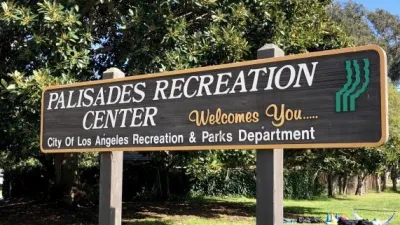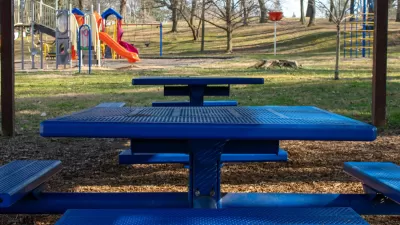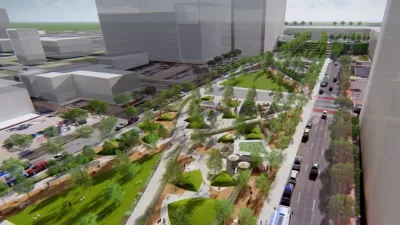A new study analyzing the amenities in 165 parks in the four-county Kansas City metro region found that low-income neighborhoods suffer from a lack of play spaces, despite having more parks per capita, reports Emily Badger.

"Low-income, minority neighborhoods in cities are often heavily disinvested places, with less money spent there on road repair, civic infrastructure or cultural projects than in other parts of town," notes Badger. "This pattern, it appears, may even extend to public parks, with the result that the children who need exercise the most may be less enticed to get it."
According to Badger, the recent study, published in the journal Annals of Behavioral Medicine, found that parks located in low-income areas of the Kansas City metro region "were less likely to have aesthetic features like decorative landscaping, trails and playgrounds." What are the implications of this inequity?
As the authors explain:
These findings are problematic because playgrounds have been shown to promote increased [physical activity] intensity and healthier weight status among children. Areas of low [socioeconomic status] are perhaps the neighborhoods that need playgrounds the most due to the increased likelihood of those areas having a higher prevalence of youth who are overweight or obese.
FULL STORY: The Inequality of Playgrounds

Alabama: Trump Terminates Settlements for Black Communities Harmed By Raw Sewage
Trump deemed the landmark civil rights agreement “illegal DEI and environmental justice policy.”

Study: Maui’s Plan to Convert Vacation Rentals to Long-Term Housing Could Cause Nearly $1 Billion Economic Loss
The plan would reduce visitor accommodation by 25% resulting in 1,900 jobs lost.

Planetizen Federal Action Tracker
A weekly monitor of how Trump’s orders and actions are impacting planners and planning in America.

Wind Energy on the Rise Despite Federal Policy Reversal
The Trump administration is revoking federal support for renewable energy, but demand for new projects continues unabated.

Passengers Flock to Caltrain After Electrification
The new electric trains are running faster and more reliably, leading to strong ridership growth on the Bay Area rail system.

Texas Churches Rally Behind ‘Yes in God’s Back Yard’ Legislation
Religious leaders want the state to reduce zoning regulations to streamline leasing church-owned land to housing developers.
Urban Design for Planners 1: Software Tools
This six-course series explores essential urban design concepts using open source software and equips planners with the tools they need to participate fully in the urban design process.
Planning for Universal Design
Learn the tools for implementing Universal Design in planning regulations.
Caltrans
Smith Gee Studio
Institute for Housing and Urban Development Studies (IHS)
City of Grandview
Harvard GSD Executive Education
Toledo-Lucas County Plan Commissions
Salt Lake City
NYU Wagner Graduate School of Public Service





























